World War II
World War II
From Wikipedia, the free encyclopedia
"The Second World War" and "WWII" redirect here. For other uses, see The Second World War (disambiguation) and WWII (disambiguation).
| ||||||||||||||||||||||||
| ||||||||||||||||||||||||
World War II (WWII or WW2), also known as the Second World War, was a global war that lasted from 1939 to 1945, though related conflicts began earlier. It involved the vast majority of the world's nations—including all of the great powers—eventually forming two opposing military alliances: the Allies and the Axis. It was the most widespread war in history, and directly involved more than 100 million people from over 30 countries. In a state of "total war", the major participants threw their entire economic, industrial, and scientific capabilities behind the war effort, erasing the distinction between civilian andmilitary resources. Marked by mass deaths of civilians, including the Holocaust (in which approximately 11 million people were killed)[1][2] and the strategic bombing of industrial and population centres (in which approximately one million were killed, and which included the atomic bombings of Hiroshima and Nagasaki),[3] it resulted in an estimated 50 million to 85 million fatalities. These made World War II the deadliest conflict in human history.[4]
The Empire of Japan aimed to dominate Asia and the Pacific and was already at war with the Republic of China in 1937,[5]but the world war is generally said to have begun on 1 September 1939[6] with the invasion of Poland by Germany and subsequent declarations of war on Germany by France and the United Kingdom. From late 1939 to early 1941, in a series of campaigns and treaties, Germany conquered or controlled much of continental Europe, and formed the Axis alliance withItaly and Japan. Based on the Molotov–Ribbentrop Pact of August 1939, Germany and the Soviet Union partitioned and annexed territories of their European neighbours, Poland, Finland, Romania and the Baltic states. For a year starting in late June 1940, the United Kingdom and the British Commonwealth were the only Allied forces continuing the fight against the European Axis powers, with campaigns in North Africa and the Horn of Africa, the aerial Battle of Britain and the Blitzbombing campaign, as well as the long-running Battle of the Atlantic. In June 1941, the European Axis powers launched an invasion of the Soviet Union, opening the largest land theatre of war in history, which trapped the major part of the Axis' military forces into a war of attrition. In December 1941, Japan attacked the United States and European territories in the Pacific Ocean, and quickly conquered much of the Western Pacific.
The Axis advance halted in 1942 when Japan lost the critical Battle of Midway, near Hawaii, and Germany was defeated inNorth Africa and then, decisively, at Stalingrad in the Soviet Union. In 1943, with a series of German defeats on the Eastern Front, the Allied invasion of Italy which brought about Italian surrender, and Allied victories in the Pacific, the Axis lost the initiative and undertook strategic retreat on all fronts. In 1944, the Western Allies invaded German-occupied France, while the Soviet Union regained all of its territorial losses and invaded Germany and its allies. During 1944 and 1945 the Japanese suffered major reverses in mainland Asia in South Central China and Burma, while the Allies crippled the Japanese Navy and captured key Western Pacific islands.
The war in Europe ended with an invasion of Germany by the Western Allies and the Soviet Union culminating in the capture of Berlin by Soviet and Polish troops and the subsequent German unconditional surrender on 8 May 1945. Following thePotsdam Declaration by the Allies on 26 July 1945 and the refusal of Japan to surrender under its terms, the United Statesdropped atomic bombs on the Japanese cities of Hiroshima and Nagasaki on 6 August and 9 August respectively. With aninvasion of the Japanese archipelago imminent, the possibility of additional atomic bombings, and the Soviet Union's declaration of war on Japan and invasion of Manchuria, Japan surrendered on 15 August 1945. Thus ended the war in Asia, cementing the total victory of the Allies.
World War II altered the political alignment and social structure of the world. The United Nations (UN) was established to foster international co-operation and prevent future conflicts. The victorious great powers—the United States, the Soviet Union, China, the United Kingdom, and France—became the permanent members of the United Nations Security Council.[7]The Soviet Union and the United States emerged as rival superpowers, setting the stage for the Cold War, which lasted for the next 46 years. Meanwhile, the influence of European great powers waned, while the decolonisation of Asia and Africabegan. Most countries whose industries had been damaged moved towards economic recovery. Political integration, especially in Europe, emerged as an effort to end pre-war enmities and to create a common identity.[8]
Contents
[hide]- 1Chronology
- 2Background
- 3Pre-war events
- 4Course of the war
- 4.1War breaks out in Europe (1939–40)
- 4.2Western Europe (1940–41)
- 4.3Mediterranean (1940–41)
- 4.4Axis attack on the USSR (1941)
- 4.5War breaks out in the Pacific (1941)
- 4.6Axis advance stalls (1942–43)
- 4.7Allies gain momentum (1943–44)
- 4.8Allies close in (1944)
- 4.9Axis collapse, Allied victory (1944–45)
- 5Aftermath
- 6Impact
- 7See also
- 8Notes
- 9Citations
- 10References
- 11External links
Chronology
See also: Timeline of World War II
The start of the war in Europe is generally held to be 1 September 1939,[9][10] beginning with the German invasion of Poland; Britain and France declared war on Germany two days later. The dates for the beginning of war in the Pacific include the start of the Second Sino-Japanese War on 7 July 1937,[11] or even the Japanese invasion of Manchuria on 19 September 1931.[12][13]
Others follow the British historian A. J. P. Taylor, who held that the Sino-Japanese War and war in Europe and its colonies occurred simultaneously and the two wars merged in 1941. This article uses the conventional dating. Other starting dates sometimes used for World War II include the Italian invasion of Abyssinia on 3 October 1935.[14] The British historian Antony Beevor views the beginning of the Second World War as the Battles of Khalkhin Gol fought between Japan and the forces of Mongolia and the Soviet Union from May to September 1939.[15]
The exact date of the war's end is also not universally agreed upon. It was generally accepted at the time that the war ended with the armistice of 14 August 1945 (V-J Day), rather than the formal surrender of Japan (2 September 1945). A peace treaty with Japan was signed in 1951 to formally tie up any loose ends such as compensation to be paid to Allied prisoners of war who had been victims of atrocities.[16] A treaty regarding Germany's future allowed the reunification of East and West Germany to take place in 1990 and resolved other post-World War II issues.[17]
Background
Main article: Causes of World War II
World War I had radically altered the political European map, with the defeat of the Central Powers—including Austria-Hungary, Germany and the Ottoman Empire—and the 1917Bolshevik seizure of power in Russia. Meanwhile, existing victorious Allies such as France, Belgium, Italy, Greece and Romania gained territories, and new Nation states were created out of the collapse of Austria-Hungary and the Ottoman and Russian Empires.
To prevent a future world war, the League of Nations was created during the 1919 Paris Peace Conference. The organisation's primary goals were to prevent armed conflict through collective security, military and naval disarmament, and settling international disputes through peaceful negotiations and arbitration.
Despite strong pacifist sentiment after World War I,[18] its aftermath still caused irredentist and revanchist nationalism in several European states. These sentiments were especially marked in Germany because of the significant territorial, colonial, and financial losses incurred by the Treaty of Versailles. Under the treaty, Germany lost around 13 percent of its home territory and all of its overseas colonies, while German annexation of other states was prohibited, reparations were imposed, and limits were placed on the size and capability of the country's armed forces.[19]
The German Empire was dissolved in the German Revolution of 1918–1919, and a democratic government, later known as the Weimar Republic, was created. The interwar period saw strife between supporters of the new republic and hardline opponents on both the right and left. Italy, as an Entente ally, had made some post-war territorial gains; however, Italian nationalists were angered that the promises made by Britain and France to secure Italian entrance into the war were not fulfilled with the peace settlement. From 1922 to 1925, the Fascist movement led by Benito Mussolini seized power in Italy with a nationalist, totalitarian, and class collaborationist agenda that abolished representative democracy, repressed socialist, left-wing and liberal forces, and pursued an aggressive expansionist foreign policy aimed at forging Italy as a world power, promising the creation of a "New Roman Empire".[20]
The Kuomintang (KMT) party in China launched a unification campaign against regional warlords and nominally unified China in the mid-1920s, but was soon embroiled in a civil war against its former Chinese communist allies.[21] In 1931, an increasingly militaristic Japanese Empire, which had long sought influence in China[22] as the first step of what its government saw as the country's right to rule Asia, used the Mukden Incident as a pretext to launch an invasion of Manchuria and establish the puppet state of Manchukuo.[23]
Too weak to resist Japan, China appealed to the League of Nations for help. Japan withdrew from the League of Nations after beingcondemned for its incursion into Manchuria. The two nations then fought several battles, in Shanghai, Rehe and Hebei, until the Tanggu Truce was signed in 1933. Thereafter, Chinese volunteer forces continued the resistance to Japanese aggression in Manchuria, andChahar and Suiyuan.[24]
Adolf Hitler, after an unsuccessful attempt to overthrow the German government in 1923, eventually became the Chancellor of Germany in 1933. He abolished democracy, espousing aradical, racially motivated revision of the world order, and soon began a massive rearmament campaign.[25] It was at this time that multiple political scientists began to predict that a second Great War might take place.[26] Meanwhile, France, to secure its alliance, allowed Italy a free hand in Ethiopia, which Italy desired as a colonial possession. The situation was aggravated in early 1935 when the Territory of the Saar Basin was legally reunited with Germany and Hitler repudiated the Treaty of Versailles, accelerated his rearmament programme and introduced conscription.[27]
Hoping to contain Germany, the United Kingdom, France and Italy formed the Stresa Front; however, in June 1935, the United Kingdom made an independent naval agreement with Germany, easing prior restrictions. The Soviet Union, concerned by Germany's goals of capturing vast areas of eastern Europe, drafted a treaty of mutual assistance with France. Before taking effect though, the Franco-Soviet pact was required to go through the bureaucracy of the League of Nations, which rendered it essentially toothless.[28] The United States, concerned with events in Europe and Asia, passed the Neutrality Act in August of the same year.[29]
Hitler defied the Versailles and Locarno treaties by remilitarising the Rhineland in March 1936. He encountered little opposition from other European powers.[30] In October 1936, Germany and Italy formed the Rome–Berlin Axis. A month later, Germany and Japan signed the Anti-Comintern Pact, which Italy would join in the following year. In China, after the Xi'an Incident, the Kuomintang and communist forces agreed on a ceasefire to present a united front to oppose Japan.[31]
Pre-war events
Italian invasion of Ethiopia (1935)
Main article: Second Italo-Abyssinian War
The Second Italo–Abyssinian War was a brief colonial war that began in October 1935 and ended in May 1936. The war began with the invasion of the Ethiopian Empire (also known as Abyssinia) by the armed forces of the Kingdom of Italy (Regno d'Italia), which was launched from Italian Somaliland and Eritrea.[32] The war resulted in the military occupation of Ethiopia and its annexation into the newly created colony of Italian East Africa (Africa Orientale Italiana, or AOI); in addition, it exposed the weakness of the League of Nations as a force to preserve peace. Both Italy and Ethiopia were member nations, but the League did nothing when the former clearly violated the League's own Article X.[33] Germany was the only major European nation to support the invasion. Italy subsequently dropped its objections to Germany's goal of absorbing Austria.[34]
Spanish Civil War (1936–39)
Main article: Spanish Civil War
When civil war broke out in Spain, Hitler and Mussolini lent military support to the Nationalist rebels, led by General Francisco Franco. The Soviet Union supported the existing government, the Spanish Republic. Over 30,000 foreign volunteers, known as the International Brigades, also fought against the Nationalists. Both Germany and the USSR used this proxy war as an opportunity to test in combat their most advanced weapons and tactics. The bombing of Guernica by the German Condor Legion in April 1937 heightened widespread concerns that the next major war would include extensive terror bombing attacks on civilians.[35][36] The Nationalists won the civil war in April 1939; Franco, now dictator, bargained with both sides during the Second World War, but never concluded any major agreements. He did send volunteers to fight on the Eastern Front under German command but Spain remained neutral and did not allow either side to use its territory.[37]
Japanese invasion of China (1937)
Main article: Second Sino-Japanese War
See also: Nanshin-ron
In July 1937, Japan captured the former Chinese imperial capital of Beijing after instigating theMarco Polo Bridge Incident, which culminated in the Japanese campaign to invade all of China.[38] The Soviets quickly signed a non-aggression pact with China to lend materiel support, effectively ending China's prior co-operation with Germany. Generalissimo Chiang Kai-shek deployed his best army to defend Shanghai, but, after three months of fighting, Shanghai fell. The Japanese continued to push the Chinese forces back, capturing the capital Nanking in December 1937. After the fall of Nanking, tens of thousands if not hundreds of thousands of Chinese civilians and disarmed combatants were murdered by the Japanese.[39][40]
In March 1938, Nationalist Chinese forces won their first major victory at Taierzhuang but then the city of Xuzhou was taken by Japanesein May.[41] In June 1938, Chinese forces stalled the Japanese advance by flooding the Yellow River; this manoeuvre bought time for the Chinese to prepare their defences at Wuhan, but the city was taken by October.[42] Japanese military victories did not bring about the collapse of Chinese resistance that Japan had hoped to achieve; instead the Chinese government relocated inland to Chongqing and continued the war.[43][44]
Soviet-Japanese border conflicts
Main article: Soviet–Japanese border conflicts
Japanese forces in Manchukuo had sporadic border clashes with the Soviet Union and Mongolia, culminating in the Japanese defeat atKhalkin Gol in 1939. After this, Japan and the Soviet Union signed a Neutrality Pact in April 1941, and Japan turned its focus further south which would eventually lead to its war with the United States and the Western Allies.[45][46]
European occupations and agreements
Further information: Anschluss, Appeasement, Munich Agreement, German occupation of Czechoslovakia and Molotov–Ribbentrop Pact
In Europe, Germany and Italy were becoming more aggressive. In March 1938, Germany annexed Austria, again provoking little response from other European powers.[47] Encouraged, Hitler began pressing German claims on theSudetenland, an area of Czechoslovakia with a predominantly ethnic German population; and soon Britain and France followed the counsel of prime minister Neville Chamberlain and conceded this territory to Germany in the Munich Agreement, which was made against the wishes of the Czechoslovak government, in exchange for a promise of no further territorial demands.[48] Soon afterwards, Germany and Italy forced Czechoslovakia to cede additional territory to Hungary and Poland.[49]
Although all of Germany's stated demands had been satisfied by the agreement, privately Hitler was furious that British interference had prevented him from seizing all of Czechoslovakia in one operation. In subsequent speeches Hitler attacked British and Jewish "war-mongers" and in January 1939 secretly ordered a major build-up of the German navy to challenge British naval supremacy. In March 1939, Germany invaded the remainder of Czechoslovakia and subsequently split it into the German Protectorate of Bohemia and Moraviaand a pro-German client state, the Slovak Republic.[50] Hitler also delivered an ultimatum to Lithuania, forcing the concession of theKlaipėda Region.
Greatly alarmed and with Hitler making further demands on the Free City of Danzig, Britain and France guaranteed their support for Polish independence; when Italy conquered Albania in April 1939, the same guarantee was extended to Romania and Greece.[51] Shortly after the Franco-British pledge to Poland, Germany and Italy formalised their own alliance with the Pact of Steel.[52] Hitler accused Britain and Poland of trying to "encircle" Germany and renounced the Anglo-German Naval Agreement and the German–Polish Non-Aggression Pact.
In August 1939, Germany and the Soviet Union signed the Molotov–Ribbentrop Pact,[53] a non-aggression treaty with a secret protocol. The parties gave each other rights to "spheres of influence" (western Poland and Lithuania for Germany; eastern Poland, Finland,Estonia, Latvia and Bessarabia for the USSR). It also raised the question of continuing Polish independence.[54] The agreement was crucial to Hitler because it assured that Germany would not have to face the prospect of a two-front war, as it had in World War I, after it defeated Poland.
The situation reached a general crisis in late August as German troops continued to mobilise against the Polish border. In a private meeting with the Italian foreign minister, Count Ciano, Hitler asserted that Poland was a "doubtful neutral" that needed to either yield to his demands or be "liquidated" to prevent it from drawing off German troops in the future "unavoidable" war with the Western democracies. He did not believe Britain or France would intervene in the conflict.[55] On 23 August Hitler ordered the attack to proceed on 26 August, but upon hearing that Britain had concluded a formal mutual assistance pact with Poland and that Italy would maintain neutrality, he decided to delay it.[56] In response to British demands for direct negotiations, Germany demanded on 29 August that a Polish plenipotentiary immediately travel to Berlin to negotiate the handover of Danzig and the Polish Corridor to Germany as well as to agree to safeguard the German minority in Poland. The Poles refused to comply with this request and on the night of 30–31 August in a violent interview with Neville Henderson, Ribbentrop declared that Germany considered its proposals rejected.[57]
Course of the war
Further information: Diplomatic history of World War II
War breaks out in Europe (1939–40)
Main articles: Invasion of Poland, Occupation of Poland (1939–45), Nazi crimes against the Polish nation, Soviet invasion of Poland and Soviet repressions of Polish citizens (1939–46)
On 1 September 1939, Germany invaded Poland under the false pretext that the Poles had carried out a series of sabotage operationsagainst German targets.[58] Two days later, on 3 September, after a British ultimatum to Germany to cease military operations was ignored, France and the United Kingdom, followed by the fully independent Dominions[59] of the British Commonwealth[60]—Australia (3 September), Canada (10 September), New Zealand (3 September), and South Africa (6 September)—declared war on Germany. However, initially the alliance provided limited direct military support to Poland, consisting of a cautious, half-hearted French probe into the Saarland.[61] The Western Allies also began a naval blockade of Germany, which aimed to damage the country's economy and war effort.[62] Germany responded by ordering U-boat warfare against Allied merchant and warships, which was to later escalate into the Battle of the Atlantic.
On 17 September 1939, after signing a cease-fire with Japan, the Soviets invaded Poland from the east.[63] The Polish army was defeated and Warsaw surrendered to the Germans on 27 September, with final pockets of resistance surrendering on 6 October. Poland's territory was divided between Germany and the Soviet Union, with Lithuania and Slovakia also receiving small shares. After the defeat of Poland's armed forces, the Polish resistance established an Underground State and a partisan Home Army.[64]About 100,000 Polish military personnel were evacuated to Romania and the Baltic countries; many of these soldiers later fought against the Germans in other theatres of the war.[65] Poland's Enigma codebreakers were also evacuated to France.[66]
On 6 October Hitler made a public peace overture to the United Kingdom and France, but said that the future of Poland was to be determined exclusively by Germany and the Soviet Union. Chamberlain rejected this on 12 October, saying "Past experience has shown that no reliance can be placed upon the promises of the present German Government."[57] After this rejection Hitler ordered an immediate offensive against France,[67] but bad weather forced repeated postponements until the spring of 1940.[68][69][70]
After signing the German–Soviet Treaty of Friendship, Cooperation and Demarcation, the Soviet Union forced the Baltic countries—Estonia, Latvia and Lithuania—to allow it to station Soviet troops in their countries under pacts of "mutual assistance".[71][72][73] Finland rejected territorial demands, prompting a Soviet invasion in November 1939.[74] The resulting Winter War ended in March 1940 withFinnish concessions.[75] The United Kingdom and France treating the Soviet attack on Finland as tantamount to its entering the war on the side of the Germans, responded to the Soviet invasion by supporting the USSR's expulsion from the League of Nations.[73]
In June 1940, the Soviet Union forcibly annexed Estonia, Latvia and Lithuania,[72] and the disputed Romanian regions of Bessarabia, Northern Bukovina and Hertza. Meanwhile, Nazi-Soviet political rapprochement and economic co-operation[76][77] gradually stalled,[78][79]and both states began preparations for war.[80]
Western Europe (1940–41)
In April 1940, Germany invaded Denmark and Norway to protect shipments ofiron ore from Sweden, which the Allies were attempting to cut off by unilaterally mining neutral Norwegian waters.[81] Denmark capitulated after a few hours, and despite Allied support, during which the important harbour of Narvik temporarily was recaptured from the Germans, Norway was conquered within two months.[82] British discontent over the Norwegian campaign led to the replacement of the British Prime Minister, Neville Chamberlain, with Winston Churchill on 10 May 1940.[83]
Germany launched an offensive against France and, adhering to the Manstein Plan also attacked the neutral nations ofBelgium, the Netherlands, and Luxembourg on 10 May 1940.[84] That same day British forces landed in Iceland and theFaroes to preempt a possible German invasion of the islands.[85] The U.S. in close co-operation with the Danish envoy to Washington D.C., agreed to protect Greenland, laying the political framework for the formal establishment of bases in April 1941. The Netherlands and Belgium were overrun using blitzkrieg tactics in a few days and weeks, respectively.[86]The French-fortified Maginot Line and the main body the Allied forces which had moved into Belgium were circumvented by a flanking movement through the thickly wooded Ardennes region,[87] mistakenly perceived by Allied planners as an impenetrable natural barrier against armoured vehicles.[88][89] As a result, the bulk of the Allied armies found themselves trapped in an encirclement and were beaten. The majority were taken prisoner, whilst over 300,000, mostly British and French, were evacuated from the continent at Dunkirk by early June, although abandoning almost all of their equipment.[90]
On 10 June, Italy invaded France, declaring war on both France and the United Kingdom.[91] Paris fell to the Germans on 14 June and eight days later France signed an armistice with Germany and was soon divided into German and Italian occupation zones,[92] and an unoccupied rump state under the Vichy Regime, which, though officially neutral, was generally aligned with Germany. France kept its fleet but the British feared the Germans would seize it, so on 3 July, the British attacked it.[93]
On 19 July, Hitler again publicly offered to end the war, saying he had no desire to destroy the British Empire. The United Kingdom rejected this, with Lord Halifax responding "there was in his speech no suggestion that peace must be based on justice, no word of recognition that the other nations of Europe had any right to self‑determination ..."[94]
Following this, Germany began an air superiority campaign over the United Kingdom (the Battle of Britain) to prepare for an invasion.[95]The campaign failed, and the invasion plans were cancelled by September.[95] Frustrated, and in part in response to repeated British air raids against Berlin, Germany began a strategic bombing offensive against British cities known as the Blitz.[96] However, the air attacks largely failed to disrupt the British war effort.
Using newly captured French ports, the German Navy enjoyed success against an over-extendedRoyal Navy, using U-boats against British shipping in the Atlantic.[97] The British scored a significant victory on 27 May 1941 by sinking the German battleship Bismarck.[98] Perhaps most importantly, during the Battle of Britain the Royal Air Force had successfully resisted the Luftwaffe's assault, and the German bombing campaign largely ended in May 1941.[99]
Throughout this period, the neutral United States took measures to assist China and the Western Allies. In November 1939, the AmericanNeutrality Act was amended to allow "cash and carry" purchases by the Allies.[100] In 1940, following the German capture of Paris, the size of the United States Navy was significantly increased. In September, the United States further agreed to a trade of American destroyers for British bases.[101] Still, a large majority of the American public continued to oppose any direct military intervention into the conflict well into 1941.[102]
Although Roosevelt had promised to keep the United States out of the war, he nevertheless took concrete steps to prepare for war. In December 1940 he accused Hitler of planning world conquest and ruled out negotiations as useless, calling for the US to become an "arsenal for democracy" and promoted the passage of Lend-Lease aid to support the British war effort.[94] In January 1941 secret high level staff talks with the British began for the purposes of determining how to defeat Germany should the US enter the war. They decided on a number of offensive policies, including an air offensive, the "early elimination" of Italy, raids, support of resistance groups, and the capture of positions to launch an offensive against Germany.[103]
At the end of September 1940, the Tripartite Pact united Japan, Italy and Germany to formalise the Axis Powers. The Tripartite Pact stipulated that any country, with the exception of the Soviet Union, not in the war which attacked any Axis Power would be forced to go to war against all three.[104] The Axis expanded in November 1940 when Hungary, Slovakia and Romania joined the Tripartite Pact.[105] Romania would make a major contribution (as did Hungary) to the Axis war against the USSR, partially to recaptureterritory ceded to the USSR, partially to pursue its leader Ion Antonescu's desire to combat communism.[106]
Mediterranean (1940–41)
Italy began operations in the Mediterranean, initiating a siege of Malta in June, conquering British Somaliland in August, and making an incursion into British-held Egypt in September 1940. In October 1940, Italy started the Greco-Italian War because of Mussolini's jealousy of Hitler's success but within days was repulsed and pushed back into Albania, where a stalemate soon occurred.[107] The United Kingdom responded to Greek requests for assistance by sending troops to Crete and providing air support to Greece. Hitler decided that when the weather improved he would take action against Greece to assist the Italians and prevent the British from gaining a foothold in the Balkans, to strike against the British naval dominance of the Mediterranean, and to secure his hold on Romanian oil.[108]
In December 1940, British Commonwealth forces began counter-offensives against Italian forces in Egypt and Italian East Africa.[109] The offensive in North Africa was highly successful and by early February 1941 Italy had lost control of eastern Libya and large numbers of Italian troops had been taken prisoner. The Italian Navy also suffered significant defeats, with the Royal Navy putting three Italian battleships out of commission by a carrier attack at Taranto, and neutralising several more warships at the Battle of Cape Matapan.[110]
The Germans soon intervened to assist Italy. Hitler sent German forces to Libya in February, and by the end of March they had launched an offensive which drove back the Commonwealth forces which had been weakened to support Greece.[111] In under a month, Commonwealth forces were pushed back into Egypt with the exception of the besieged port of Tobruk.[112] The Commonwealthattempted to dislodge Axis forces in May and again in June, but failed on both occasions.[113]
By late March 1941, following Bulgaria's signing of the Tripartite Pact, the Germans were in position to intervene in Greece. Plans were changed, however, because of developments in neighbouring Yugoslavia. The Yugoslav government had signed the Tripartite Pact on 25 March, only to be overthrown two days later by a British-encouraged coup. Hitler viewed the new regime as hostile and immediately decided to eliminate it. On 6 April Germany simultaneously invaded both Yugoslavia and Greece, making rapid progress and forcing both nations to surrender within the month. The British were driven from the Balkans after Germany conquered the Greek island of Crete by the end of May.[114] Although the Axis victory was swift, bitter partisan warfare subsequently broke out against the Axis occupation of Yugoslavia, which continued until the end of the war.
The Allies did have some successes during this time. In the Middle East, Commonwealth forces first quashed an uprising in Iraq which had been supported by German aircraft from bases within Vichy-controlled Syria,[115] then, with the assistance of the Free French, invaded Syria and Lebanon to prevent further such occurrences.[116]
Axis attack on the USSR (1941)
Further information: Operation Barbarossa, Einsatzgruppen, World War II casualties of the Soviet Union and Nazi crimes against Soviet POWs
With the situation in Europe and Asia relatively stable, Germany, Japan, and the Soviet Union made preparations. With the Soviets wary of mounting tensions with Germany and the Japanese planning to take advantage of the European War by seizing resource-rich European possessions in Southeast Asia, the two powers signed the Soviet–Japanese Neutrality Pact in April 1941.[117] By contrast, the Germans were steadily making preparations for an attack on the Soviet Union, massing forces on the Soviet border.[118]
Hitler believed that Britain's refusal to end the war was based on the hope that the United States and the Soviet Union would enter the war against Germany sooner or later.[119] He therefore decided to try to strengthen Germany's relations with the Soviets, or failing that, to attack and eliminate them as a factor. In November 1940, negotiations took place to determine if the Soviet Union would join the Tripartite Pact. The Soviets showed some interest, but asked for concessions from Finland, Bulgaria, Turkey, and Japan that Germany considered unacceptable. On 18 December 1940, Hitler issued the directive to prepare for an invasion of the Soviet Union.
On 22 June 1941, Germany, supported by Italy and Romania, invaded the Soviet Union in Operation Barbarossa, with Germany accusing the Soviets of plotting against them. They were joined shortly by Finland and Hungary.[120] The primary targets of this surprise offensive[121] were the Baltic region, Moscow and Ukraine, with the ultimate goal of ending the 1941 campaign near theArkhangelsk-Astrakhan line, from the Caspian to the White Seas. Hitler's objectives were to eliminate the Soviet Union as a military power, exterminate Communism, generate Lebensraum ("living space")[122] by dispossessing the native population[123] and guarantee access to the strategic resources needed to defeat Germany's remaining rivals.[124]
Although the Red Army was preparing for strategic counter-offensives before the war,[125] Barbarossa forced the Soviet supreme command to adopt a strategic defence. During the summer, the Axis made significant gains into Soviet territory, inflicting immense losses in both personnel and materiel. By the middle of August, however, the German Army High Command decided to suspend the offensive of a considerably depleted Army Group Centre, and to divert the 2nd Panzer Group to reinforce troops advancing towards central Ukraine and Leningrad.[126] The Kiev offensive was overwhelmingly successful, resulting in encirclement and elimination of four Soviet armies, and made further advance into Crimea and industrially developed Eastern Ukraine (the First Battle of Kharkov) possible.[127]
The diversion of three quarters of the Axis troops and the majority of their air forces from France and the central Mediterranean to theEastern Front[128] prompted Britain to reconsider its grand strategy.[129] In July, the UK and the Soviet Union formed a military alliance against Germany[130] The British and Soviets invaded Iran to secure the Persian Corridor and Iran's oil fields.[131] In August, the United Kingdom and the United States jointly issued the Atlantic Charter.[132]
By October Axis operational objectives in Ukraine and the Baltic region were achieved, with only the sieges of Leningrad[133] and Sevastopol continuing.[134] A major offensive against Moscow was renewed; after two months of fierce battles in increasingly harsh weather the German army almost reached the outer suburbs of Moscow, where the exhausted troops[135] were forced to suspend their offensive.[136] Large territorial gains were made by Axis forces, but their campaign had failed to achieve its main objectives: two key cities remained in Soviet hands, the Soviet capability to resist was not broken, and the Soviet Union retained a considerable part of its military potential. The blitzkriegphase of the war in Europe had ended.[137]
By early December, freshly mobilised reserves[138] allowed the Soviets to achieve numerical parity with Axis troops.[139] This, as well as intelligence data which established that a minimal number of Soviet troops in the East would be sufficient to deter any attack by the Japanese Kwantung Army,[140] allowed the Soviets to begin a massive counter-offensivethat started on 5 December all along the front and pushed German troops 100–250 kilometres (62–155 mi) west.[141]
War breaks out in the Pacific (1941)
In 1939 the United States had renounced its trade treaty with Japan and beginning with an aviation gasoline ban in July 1940 Japan had become subject to increasing economic pressure.[94] During this time, Japan launched its first attack against Changsha, a strategically important Chinese city, but was repulsed by late September.[142] Despite several offensives by both sides, the war between China and Japan was stalemated by 1940. To increase pressure on China by blocking supply routes, and to better position Japanese forces in the event of a war with the Western powers, Japan invaded and occupied northern Indochina.[143] Afterwards, the United States embargoediron, steel and mechanical parts against Japan.[144] Other sanctions soon followed.
In August of that year, Chinese communists launched an offensive in Central China; in retaliation, Japan instituted harsh measures in occupied areas to reduce human and material resources for the communists.[145] Continued antipathy between Chinese communist and nationalist forces culminated in armed clashes in January 1941, effectively ending their co-operation.[146] In March, the Japanese 11th army attacked the headquarters of the Chinese 19th army but was repulsed during Battle of Shanggao.[147] In September, Japan attempted to take the city of Changsha again and clashed with Chinese nationalist forces.[148]
German successes in Europe encouraged Japan to increase pressure on European governments in Southeast Asia. The Dutch government agreed to provide Japan some oil supplies from the Dutch East Indies, but negotiations for additional access to their resources ended in failure in June 1941.[149] In July 1941 Japan sent troops to southern Indochina, thus threatening British and Dutch possessions in the Far East. The United States, United Kingdom and other Western governments reacted to this move with a freeze on Japanese assets and a total oil embargo.[150][151]
Since early 1941 the United States and Japan had been engaged in negotiations in an attempt to improve their strained relations and end the war in China. During these negotiations Japan advanced a number of proposals which were dismissed by the Americans as inadequate.[152] At the same time the US, Britain, and the Netherlands engaged in secret discussions for the joint defence of their territories, in the event of a Japanese attack against any of them.[153] Roosevelt reinforced the Philippines (an American protectorate scheduled for independence in 1946) and warned Japan that the US would react to Japanese attacks against any "neighboring countries".[153]
Frustrated at the lack of progress and feeling the pinch of the American-British-Dutch sanctions, Japan prepared for war. On 20 November it presented an interim proposal as its final offer. It called for the end of American aid to China and to supply oil and other resources to Japan. In exchange they promised not to launch any attacks in Southeast Asia and to withdraw their forces from their threatening positions in southern Indochina.[152] The American counter-proposal of 26 November required that Japan evacuate all of China without conditions and conclude non-aggression pacts with all Pacific powers.[154] That meant Japan was essentially forced to choose between abandoning its ambitions in China, or seizing the natural resources it needed in the Dutch East Indies by force;[155] the Japanese military did not consider the former an option, and many officers considered the oil embargo an unspoken declaration of war.[156]
Japan planned to rapidly seize European colonies in Asia to create a large defensive perimeter stretching into the Central Pacific; the Japanese would then be free to exploit the resources of Southeast Asia while exhausting the over-stretched Allies by fighting a defensive war.[157] To prevent American intervention while securing the perimeter it was further planned to neutralise the United States Pacific Fleetand the American military presence in the Philippines from the outset.[158] On 7 December (8 December in Asian time zones), 1941, Japan attacked British and American holdings with near-simultaneous offensives against Southeast Asia and the Central Pacific.[159] These included an attack on the American fleet at Pearl Harbor, the Philippines, landings in Thailand and Malaya[159] and the battle of Hong Kong.
These attacks led the United States, Britain, China, Australia and several other states to formally declare war on Japan, whereas the Soviet Union, being heavily involved in large-scale hostilities with European Axis countries, maintained its neutrality agreement with Japan.[160] Germany, followed by the other Axis states, declared war on the United States[161] in solidarity with Japan, citing as justification the American attacks on German war vessels that had been ordered by Roosevelt.[120][162]
Axis advance stalls (1942–43)
In January 1942, the United States, Britain, Soviet Union, China, and 22 smaller or exiled governments issued the Declaration by United Nations, thereby affirming the Atlantic Charter,[163] and agreeing to not to sign a separate peace with the Axis powers.
During 1942, Allied officials debated on the appropriate grand strategy to pursue. All agreed that defeating Germany was the primary objective. The Americans favoured a straightforward, large-scale attack on Germany through France. The Soviets were also demanding a second front. The British, on the other hand, argued that military operations should target peripheral areas to throw a "ring" around Germany which would wear out German strength, lead to increasing demoralisation, and bolster resistance forces. Germany itself would be subject to a heavy bombing campaign. An offensive against Germany would then be launched primarily by Allied armour without using large-scale armies.[164] Eventually, the British persuaded the Americans that a landing in France was infeasible in 1942 and they should instead focus on driving the Axis out of North Africa.[165]
At the Casablanca Conference in early 1943, the Allies reiterated the statements issued in the 1942 Declaration by the United Nations, and demanded the unconditional surrender of their enemies. The British and Americans agreed to continue to press the initiative in the Mediterranean by invading Sicily to fully secure the Mediterranean supply routes.[166] Although the British argued for further operations in the Balkans to bring Turkey into the war, in May 1943, the Americans extracted a British commitment to limit Allied operations in the Mediterranean to an invasion of the Italian mainland and to invade France in 1944.[167]
Pacific (1942–43)
By the end of April 1942, Japan and its ally Thailand had almost fully conquered Burma, Malaya, the Dutch East Indies, Singapore, and Rabaul, inflicting severe losses on Allied troops and taking a large number of prisoners.[168]Despite stubborn resistance by Filipino and US forces, the Philippine Commonwealth was eventually captured in May 1942, forcing its government into exile.[169] On 16 April, in Burma, 7,000 British soldiers were encircled by the Japanese 33rd Division during the Battle of Yenangyaung and rescued by the Chinese 38th Division.[170] Japanese forces also achieved naval victories in the South China Sea, Java Sea and Indian Ocean,[171] and bombed the Allied naval base at Darwin, Australia. In January 1942, the only Allied success against Japan was a Chinese victory at Changsha.[172] These easy victories over unprepared US and European opponents left Japan overconfident, as well as overextended.[173]
In early May 1942, Japan initiated operations to capture Port Moresby by amphibious assault and thus sever communications and supply lines between the United States and Australia. The Allies, however, prevented the invasion by intercepting and defeating the Japanese naval forces in the Battle of the Coral Sea.[174] Japan's next plan, motivated by the earlier Doolittle Raid, was to seize Midway Atoll and lure American carriers into battle to be eliminated; as a diversion, Japan would also send forces to occupy the Aleutian Islands in Alaska.[175] In early June, Japan put its operations into action but the Americans, having broken Japanese naval codes in late May, were fully aware of the plans and force dispositions and used this knowledge to achieve a decisive victory at Midway over the Imperial Japanese Navy.[176]
With its capacity for aggressive action greatly diminished as a result of the Midway battle, Japan chose to focus on a belated attempt to capture Port Moresby by an overland campaign in the Territory of Papua.[177] The Americans planned a counter-attack against Japanese positions in the southern Solomon Islands, primarily Guadalcanal, as a first step towards capturing Rabaul, the main Japanese base in Southeast Asia.[178]
Both plans started in July, but by mid-September, the Battle for Guadalcanal took priority for the Japanese, and troops in New Guinea were ordered to withdraw from the Port Moresby area to the northern part of the island, where they faced Australian and United States troops in the Battle of Buna-Gona.[179] Guadalcanal soon became a focal point for both sides with heavy commitments of troops and ships in the battle for Guadalcanal. By the start of 1943, the Japanese were defeated on the island and withdrew their troops.[180] In Burma, Commonwealth forces mounted two operations. The first, an offensive into the Arakan region in late 1942, went disastrously, forcing a retreat back to India by May 1943.[181] The second was the insertion of irregular forces behind Japanese front-lines in February which, by the end of April, had achieved mixed results.[182]
Eastern Front (1942–43)
Despite considerable losses, in early 1942 Germany and its allies stopped a major Soviet offensive in central and southern Russia, keeping most territorial gains they had achieved during the previous year.[183] In May the Germans defeated Soviet offensives in the Kerch Peninsula and at Kharkiv,[184] and then launched their main summer offensive against southern Russia in June 1942, to seize the oil fields of the Caucasus and occupy Kuban steppe, while maintaining positions on the northern and central areas of the front. The Germans split Army Group South into two groups: Army Group A advanced to the lower Don River and struck south-east to the Caucasus, while Army Group B headed towards the Volga River. The Soviets decided to make their stand at Stalingrad on the Volga.[185]
By mid-November, the Germans had nearly taken Stalingrad in bitter street fighting when the Soviets began their second winter counter-offensive, starting with an encirclement of German forces at Stalingrad[186] and an assault on the Rzhev salient near Moscow, though the latter failed disastrously.[187] By early February 1943, the German Army had taken tremendous losses; German troops at Stalingrad had been forced to surrender,[188] and the front-line had been pushed back beyond its position before the summer offensive. In mid-February, after the Soviet push had tapered off, the Germans launched another attack on Kharkiv, creating a salient in their front line around the Russian city of Kursk.[189]
Western Europe/Atlantic & Mediterranean (1942–43)
Exploiting poor American naval command decisions, the German navy ravaged Allied shipping off the American Atlantic coast.[190] By November 1941, Commonwealth forces had launched a counter-offensive, Operation Crusader, in North Africa, and reclaimed all the gains the Germans and Italians had made.[191] In North Africa, the Germans launched an offensive in January, pushing the British back to positions at the Gazala Line by early February,[192] followed by a temporary lull in combat which Germany used to prepare for their upcoming offensives.[193] Concerns the Japanese might use bases in Vichy-held Madagascar caused the British to invade the island in early May 1942.[194] An Axis offensive in Libya forced an Allied retreat deep inside Egypt until Axis forces were stopped at El Alamein.[195]On the Continent, raids of Allied commandos on strategic targets, culminating in the disastrous Dieppe Raid,[196] demonstrated the Western Allies' inability to launch an invasion of continental Europe without much better preparation, equipment, and operational security.[197]
In August 1942, the Allies succeeded in repelling a second attack against El Alamein[198] and, at a high cost, managed to deliver desperately needed supplies to the besieged Malta.[199] A few months later, the Allies commenced an attack of their own in Egypt, dislodging the Axis forces and beginning a drive west across Libya.[200] This attack was followed up shortly after by Anglo-American landings in French North Africa, which resulted in the region joining the Allies.[201] Hitler responded to the French colony's defection by ordering the occupation of Vichy France;[201] although Vichy forces did not resist this violation of the armistice, they managed to scuttle their fleet to prevent its capture by German forces.[202] The now pincered Axis forces in Africa withdrew into Tunisia, which was conquered by the Allies in May 1943.[203]
In early 1943 the British and Americans began the "Combined Bomber Offensive", a strategic bombing campaign against Germany. The goals were to disrupt the German war economy, reduce German morale, and "de-house" the German civilian population.[204]
Allies gain momentum (1943–44)
Following the Guadalcanal Campaign, the Allies initiated several operations against Japan in the Pacific. In May 1943, Canadian and U.S. forces were sent to eliminate Japanese forces from the Aleutians.[205] Soon after, the U.S. with support from Australian and New Zealand forces began major operations to isolate Rabaul by capturing surrounding islands, and to breach the Japanese Central Pacific perimeter at the Gilbert and Marshall Islands.[206] By the end of March 1944, the Allies had completed both of these objectives, and additionallyneutralised the major Japanese base at Truk in the Caroline Islands. In April, the Allies then launched an operation to retake Western New Guinea.[207]
In the Soviet Union, both the Germans and the Soviets spent the spring and early summer of 1943 making preparations for large offensives in central Russia. On 4 July 1943, Germany attacked Soviet forces around the Kursk Bulge. Within a week, German forces had exhausted themselves against the Soviets' deeply echeloned and well-constructed defences[208] and, for the first time in the war, Hitler cancelled the operation before it had achieved tactical or operational success.[209] This decision was partially affected by the Western Allies' invasion of Sicily launched on 9 July which, combined with previous Italian failures, resulted in the ousting and arrest of Mussolini later that month.[210] Also, in July 1943 the British firebombed Hamburg killing over 40,000 people.
On 12 July 1943, the Soviets launched their own counter-offensives, thereby dispelling any hopes of the German Army for victory or even stalemate in the east. The Soviet victory at Kursk marked the end of German superiority,[211] giving the Soviet Union the initiative on the Eastern Front.[212][213] The Germans attempted to stabilise their eastern front along the hastily fortified Panther-Wotan line; however, the Soviets broke through it at Smolensk and by the Lower Dnieper Offensives.[214]
On 3 September 1943, the Western Allies invaded the Italian mainland, following an Italian armistice with the Allies.[215] Germany responded by disarming Italian forces, seizing military control of Italian areas,[216] and creating a series of defensive lines.[217] German special forces then rescued Mussolini, who then soon established a new client state in German occupied Italy named the Italian Social Republic,[218] causing an Italian civil war. The Western Allies fought through several lines until reaching the main German defensive line in mid-November.[219]
German operations in the Atlantic also suffered. By May 1943, as Allied counter-measures became increasingly effective, the resulting sizeable German submarine losses forced a temporary halt of the German Atlantic naval campaign.[220] In November 1943, Franklin D. Roosevelt and Winston Churchill met withChiang Kai-shek in Cairo and then with Joseph Stalin in Tehran.[221] The former conference determined the post-war return of Japanese territory,[222] while the latter included agreement that the Western Allies would invade Europe in 1944 and that the Soviet Union would declare war on Japan within three months of Germany's defeat.[223]
From November 1943, during the seven-week Battle of Changde, the Chinese forced Japan to fight a costly war of attrition, while awaiting Allied relief.[224][225][226] In January 1944, the Allies launched a series of attacks in Italy against the line at Monte Cassino and attempted to outflank it with landings at Anzio.[227] By the end of January, a major Soviet offensive expelled German forces from the Leningrad region,[228] ending the longest and most lethal siege in history.
The following Soviet offensive was halted on the pre-war Estonian border by the German Army Group North aided by Estonians hoping tore-establish national independence. This delay slowed subsequent Soviet operations in the Baltic Sea region.[229] By late May 1944, the Soviets had liberated Crimea, largely expelled Axis forces from Ukraine, and made incursions into Romania, which were repulsed by the Axis troops.[230] The Allied offensives in Italy had succeeded and, at the expense of allowing several German divisions to retreat, on 4 June, Rome was captured.[231]
The Allies experienced mixed fortunes in mainland Asia. In March 1944, the Japanese launched the first of two invasions, an operation against British positions in Assam, India,[232] and soon besieged Commonwealth positions at Imphal and Kohima.[233] In May 1944, British forces mounted a counter-offensive that drove Japanese troops back to Burma,[233] and Chinese forces that had invaded northern Burma in late 1943 besieged Japanese troops in Myitkyina.[234] The second Japanese invasion of China attempted to destroy China's main fighting forces, secure railways between Japanese-held territory and capture Allied airfields.[235] By June, the Japanese had conquered the province of Henan and begun a renewed attack against Changsha in the Hunan province.[236]
Allies close in (1944)
On 6 June 1944 (known as D-Day), after three years of Soviet pressure,[237] the Western Allies invaded northern France. After reassigning several Allied divisions from Italy, they also attacked southern France.[238] These landings were successful, and led to the defeat of theGerman Army units in France. Paris was liberated by the local resistance assisted by the Free French Forces, both led by GeneralCharles de Gaulle, on 25 August[239] and the Western Allies continued to push back German forces in western Europe during the latter part of the year. An attempt to advance into northern Germany spearheaded by a major airborne operation in the Netherlands ended with a failure.[240] After that, the Western Allies slowly pushed into Germany, unsuccessfully trying to cross the Rur river in a large offensive. In Italy the Allied advance also slowed down, when they ran into the last major German defensive line.[241]
On 22 June, the Soviets launched a strategic offensive in Belarus (known as "Operation Bagration") that resulted in the almost complete destruction of the German Army Group Centre.[242] Soon after that, another Soviet strategic offensive forced German troops from Western Ukraine and Eastern Poland. The successful advance of Soviet troops prompted resistance forces in Poland to initiate several uprisings. The largest of these was in Warsaw, where German soldiers massacred 200,000 civilians. Also, a Slovak uprising in the south did not receive Soviet support, and so was put down by German forces.[243] The Red Army's strategic offensive in eastern Romania cut off and destroyed the considerable German troops there and triggered a successful coup d'état in Romania and in Bulgaria, followed by those countries' shift to the Allied side.[244]
In September 1944, Soviet Red Army troops advanced into Yugoslavia and forced the rapid withdrawal of the German Army Groups E andF in Greece, Albania and Yugoslavia to rescue them from being cut off.[245] By this point, the Communist-led Partisans under MarshalJosip Broz Tito, who had led an increasingly successful guerrilla campaign against the occupation since 1941, controlled much of the territory of Yugoslavia and were engaged in delaying efforts against the German forces further south. In northern Serbia, the Red Army, with limited support from Bulgarian forces, assisted the Partisans in a joint liberation of the capital city of Belgrade on 20 October. A few days later, the Soviets launched a massive assault against German-occupied Hungary that lasted until the fall of Budapest in February 1945.[246] In contrast with impressive Soviet victories in the Balkans, the bitter Finnish resistance to the Soviet offensive in the Karelian Isthmus denied the Soviets occupation of Finland and led to the signing of Soviet-Finnish armistice on relatively mild conditions,[247][248]with a subsequent shift to the Allied side by Finland.
By the start of July, Commonwealth forces in Southeast Asia had repelled the Japanese sieges in Assam, pushing the Japanese back to the Chindwin River[249] while the Chinese captured Myitkyina. In China, the Japanese were having greater successes, having finally captured Changsha in mid-June and the city of Hengyang by early August.[250] Soon after, they further invaded the province of Guangxi, winning major engagements against Chinese forces at Guilin and Liuzhou by the end of November[251] and successfully linking up their forces in China and Indochina by the middle of December.[252]
In the Pacific, American forces continued to press back the Japanese perimeter. In mid-June 1944 they began their offensive against the Mariana and Palau islands, and decisively defeated Japanese forces in the Battle of the Philippine Sea. These defeats led to the resignation of the Japanese Prime Minister, Hideki Tojo, and provided the United States with air bases to launch intensive heavy bomber attacks on the Japanese home islands. In late October, American forces invaded the Filipino island of Leyte; soon after, Allied naval forces scored another large victory during the Battle of Leyte Gulf, one of the largest naval battles in history.[253]
Axis collapse, Allied victory (1944–45)
On 16 December 1944, Germany attempted its last desperate measure for success on the Western Front by using most of its remaining reserves to launch a massive counter-offensive in the Ardennes to attempt to split the Western Allies, encircle large portions of Western Allied troops and capture their primary supply port at Antwerp to prompt a political settlement.[254] By January, the offensive had been repulsed with no strategic objectives fulfilled.[254] In Italy, the Western Allies remained stalemated at the German defensive line. In mid-January 1945, the Soviets and Poles attacked in Poland, pushing from the Vistula to the Oder river in Germany, and overran East Prussia.[255] On 4 February, US, British, and Soviet leaders met for the Yalta Conference. They agreed on the occupation of post-war Germany, and on when the Soviet Union would join the war against Japan.[256]
In February, the Soviets entered Silesia and Pomerania, while Western Allies entered western Germany and closed to the Rhine river. By March, the Western Allies crossed the Rhine north and south of the Ruhr, encircling the German Army Group B,[257] while the Soviets advanced to Vienna. In early April, the Western Allies finally pushed forward in Italy and swept across western Germany, while Soviet and Polish forces stormed Berlin in late April. The American and Soviet forces linked up on Elbe river on 25 April. On 30 April 1945, theReichstag was captured, signalling the military defeat of Nazi Germany.[258]
Several changes in leadership occurred during this period. On 12 April, President Roosevelt died and was succeeded by Harry Truman. Benito Mussolini was killed by Italian partisans on 28 April.[259] Two days later, Hitler committed suicide, and was succeeded by Grand Admiral Karl Dönitz.[260]
German forces surrendered in Italy on 29 April. Total and unconditional surrender was signed on 7 May, to be effective by the end of 8 May.[261] German Army Group Centre resisted in Prague until 11 May.[262]
In the Pacific theatre, American forces accompanied by the forces of the Philippine Commonwealth advanced in the Philippines, clearing Leyte by the end of April 1945. They landed on Luzon in January 1945 and recaptured Manila in March following a battle which reduced the city to ruins. Fighting continued on Luzon, Mindanao, and other islands of the Philippines until the end of the war.[263] On the night of 9–10 March, B-29 bombers of the US Army Air Forces struck Tokyo with incendiary bombs, which killed 100,000 people within a few hours. Over the next five months, American bombers firebombed 66 other Japanese cities, causing the destruction of untold numbers of buildings and the deaths of between 350,000–500,000 Japanese civilians.[264]
In May 1945, Australian troops landed in Borneo, over-running the oilfields there. British, American, and Chinese forces defeated the Japanese in northern Burma in March, and the British pushed on to reach Rangoon by 3 May.[265] Chinese forces started to counterattack in Battle of West Hunan that occurred between 6 April and 7 June 1945. American naval and amphibious forces also moved towards Japan, taking Iwo Jima by March, and Okinawa by the end of June.[266]At the same time American bombers were destroying Japanese cities, American submarines cut off Japanese imports, drastically reducing Japan's ability to supply its overseas forces.[267]
On 11 July, Allied leaders met in Potsdam, Germany. They confirmed earlier agreements about Germany,[268] and reiterated the demand for unconditional surrender of all Japanese forces by Japan, specifically stating that "the alternative for Japan is prompt and utter destruction".[269] During this conference, the United Kingdom held its general election, and Clement Attlee replaced Churchill as Prime Minister.[270]
The Allies called for unconditional Japanese surrender in the Potsdam declaration of 27 July, but the Japanese government was internally divided on whether to make peace and did not respond. In early August the United States dropped atomic bombs on the Japanese cities of Hiroshima and Nagasaki. Like the Japanese cities previously bombed by American airmen, the US and its allies justified the atomic bombings as military necessity to avoid invading the Japanese home islands which would cost the lives of between 250,000–500,000 Allied troops and millions of Japanese troops and civilians.[271] Between the two bombings, the Soviets, pursuant to the Yalta agreement, invaded Japanese-held Manchuria, and quickly defeated the Kwantung Army, which was the largest Japanese fighting force.[272][273] The Red Army also captured Sakhalin Island and the Kuril Islands. On 15 August 1945, Japan surrendered, with thesurrender documents finally signed aboard the deck of the American battleship USS Missouri on 2 September 1945, ending the war.[274]
Aftermath
Main articles: Aftermath of World War II and Consequences of Nazism
The Allies established occupation administrations in Austria and Germany. The former became a neutral state, non-aligned with any political bloc. The latter was divided into western and eastern occupation zones controlled by the Western Allies and the USSR, accordingly. A denazification program in Germany led to the prosecution of Nazi war criminals and the removal of ex-Nazis from power, although this policy moved towards amnesty and re-integration of ex-Nazis into West German society.[275]
Germany lost a quarter of its pre-war (1937) territory. Among the eastern territories, Silesia, Neumark and most of Pomerania were taken over by Poland, East Prussia was divided between Poland and the USSR, followed by the expulsion of the 9 million Germans from these provinces, as well as the expulsion of 3 million Germans from the Sudetenland in Czechoslovakia to Germany. By the 1950s, every fifth West German was a refugee from the east. The Soviet Union also took over the Polish provinces east of the Curzon line, from which 2 million Poles were expelled;[276] north-east Romania,[277][278] parts of eastern Finland,[279] and the three Baltic states were also incorporated into the USSR.[280][281]
In an effort to maintain peace,[282] the Allies formed the United Nations, which officially came into existence on 24 October 1945,[283] and adopted the Universal Declaration of Human Rights in 1948, as a common standard for all member nations.[284] The great powers that were the victors of the war—the United States, Soviet Union, China, Britain, and France—formed the permanent members of the UN's Security Council.[7] The five permanent members remain so to the present, although there have been two seat changes, between the Republic of Chinaand the People's Republic of China in 1971, and between the Soviet Union and its successor state, the Russian Federation, following thedissolution of the Soviet Union. The alliance between the Western Allies and the Soviet Union had begun to deteriorate even before the war was over.[285]
Germany had been de facto divided, and two independent states, the Federal Republic of Germany and the German Democratic Republic[286]were created within the borders of Allied and Soviet occupation zones, accordingly. The rest of Europe was also divided into Western and Sovietspheres of influence.[287] Most eastern and central European countries fell into the Soviet sphere, which led to establishment of Communist-led regimes, with full or partial support of the Soviet occupation authorities. As a result, Poland, Hungary, East Germany,[288] Czechoslovakia,Romania, and Albania[289] became Soviet satellite states. Communist Yugoslavia conducted a fully independent policy, causing tension with the USSR.[290]
Post-war division of the world was formalised by two international military alliances, the United States-led NATO and the Soviet-led Warsaw Pact;[291] the long period of political tensions and military competition between them, the Cold War, would be accompanied by an unprecedentedarms race and proxy wars.[292]
In Asia, the United States led the occupation of Japan and administrated Japan's former islands in the Western Pacific, while the Soviets annexed Sakhalin and the Kuril Islands.[293] Korea, formerly under Japanese rule, was divided and occupied by the US in the South and the Soviet Union in the North between 1945 and 1948. Separate republics emerged on both sides of the 38th parallel in 1948, each claiming to be the legitimate government for all of Korea, which led ultimately to the Korean War.[294]
In China, nationalist and communist forces resumed the civil war in June 1946. Communist forces were victorious and established the People's Republic of China on the mainland, while nationalist forces retreated to Taiwan in 1949.[295] In the Middle East, the Arab rejection of the United Nations Partition Plan for Palestine and the creation of Israelmarked the escalation of the Arab-Israeli conflict. While European colonial powers attempted to retain some or all of their colonial empires, their losses of prestige and resources during the war rendered this unsuccessful, leading to decolonisation.[296][297]
The global economy suffered heavily from the war, although participating nations were affected differently. The US emerged much richer than any other nation; it had a baby boom and by 1950 its gross domestic product per person was much higher than that of any of the other powers and it dominated the world economy.[298] The UK and US pursued a policy of industrial disarmament in Western Germany in the years 1945–1948.[299] Because of international trade interdependencies this led to European economic stagnation and delayed European recovery for several years.[300][301]
Recovery began with the mid-1948 currency reform in Western Germany, and was sped up by the liberalisation of European economic policy that the Marshall Plan (1948–1951) both directly and indirectly caused.[302][303] The post-1948 West German recovery has been called the German economic miracle.[304] Italy also experienced an economic boom[305] and the French economy rebounded.[306] By contrast, the United Kingdom was in a state of economic ruin,[307] and although it received a quarter of the total Marshall Plan assistance, more than any other European country,[308] continued relative economic decline for decades.[309]
The Soviet Union, despite enormous human and material losses, also experienced rapid increase in production in the immediate post-war era.[310] Japan experienced incredibly rapid economic growth, becoming one of the most powerful economies in the world by the 1980s.[311] China returned to its pre-war industrial production by 1952.[312]
Impact
Casualties and war crimes
Main articles: World War II casualties, War crimes during World War II, War crimes in occupied Poland during World War II, German war crimes, War crimes of the Wehrmacht, Japanese war crimes, Allied war crimes during World War II and Soviet war crimes
Estimates for the total casualties of the war vary, because many deaths went unrecorded. Most suggest that some 75 million people died in the war, including about 20 million military personnel and 40 million civilians.[313][314][315] Many of the civilians died because of deliberate genocide, massacres, mass-bombing, disease, and starvation.
The Soviet Union lost around 27 million people during the war,[316] including 8.7 million military and 19 million civilian deaths. The largest portion of military dead were 5.7 million ethnic Russians, followed by 1.3 million ethnic Ukrainians.[317] A quarter of the people in the Soviet Union were wounded or killed.[318]Germany sustained 5.3 million military losses, mostly on the Eastern Front and during the final battles in Germany.[319]
Of the total deaths in World War II, approximately 85 percent—mostly Soviet and Chinese—were on the Allied side and 15 percent on the Axis side. Many of these deaths were caused by war crimes committed by German and Japanese forces in occupied territories. An estimated 11[320] to 17 million[321] civilians died as a direct or indirect result of Nazi ideological policies, including the systematic genocide of around 6 million Jews during the Holocaust, along with a further 5 to 6 million ethnic Poles and other Slavs(including Ukrainians and Belarusians)[322]—Roma, homosexuals, and other ethnic and minority groups.[321] Hundreds of thousands (varying estimates) of ethnic Serbs, along with gypsies and Jews, were murdered by the Axis-aligned Croatian Ustaše in Yugoslavia,[323] withretribution-related killings just after the war ended.
The best-known Japanese atrocity was the Nanking Massacre, in which several hundred thousand Chinese civilians were raped and murdered.[324] Between 3 million and more than 10 million civilians, mostly Chinese (estimated at 7.5 million[325]), were killed by the Japanese occupation forces.[326] Mitsuyoshi Himeta reported that 2.7 million casualties occurred during the Sankō Sakusen. GeneralYasuji Okamura implemented the policy in Heipei and Shantung.[327]
Axis forces employed biological and chemical weapons. The Imperial Japanese Army used a variety of such weapons during their invasion and occupation of China (see Unit 731)[328][329] and in early conflicts against the Soviets.[330] Both the Germans and Japanese tested such weapons against civilians[331] and, sometimes on prisoners of war.[332]
The Soviet Union was responsible for the Katyn massacre of 22,000 Polish officers,[333] and the imprisonment or execution of thousands of political prisoners by the NKVD,[334] in the Baltic states, and eastern Poland annexed by the Red Army.
The mass-bombing of civilian areas, notably the cities of Warsaw, Rotterdam and London; including the aerial targeting of hospitals and fleeing refugees[335] by the German Luftwaffe, along with the bombing of Tokyo, and German cities of Dresden, Hamburg and Cologne by the Western Allies may be considered as war crimes. The latter resulted in the destruction of more than 160 cities and the deaths of more than 600,000 German civilians.[336] However, no positive or specific customary international humanitarian law with respect to aerial warfare existed before or during World War II.[337]
Concentration camps, slave labour, and genocide
Further information: Genocide, The Holocaust, Nazi concentration camps, Extermination camp, Forced labour under German rule during World War II, Kidnapping of children by Nazi Germany and Nazi human experimentation
The German Government led by Adolf Hitler and the Nazi Party was responsible for the Holocaust, the killing of approximately 6 million Jews, as well as 2.7 million ethnic Poles,[338] and 4 million others who were deemed "unworthy of life" (including the disabled and mentally ill, Soviet prisoners of war, homosexuals, Freemasons, Jehovah's Witnesses, and Romani) as part of a programme of deliberate extermination. About 12 million, most of whom were Eastern Europeans, were employed in the German war economy as forced labourers.[339]
In addition to Nazi concentration camps, the Soviet gulags (labour camps) led to the death of citizens of occupied countries such as Poland, Lithuania, Latvia, and Estonia, as well as German prisoners of war (POWs) and even Soviet citizens who had been or were thought to be supporters of the Nazis.[340] Sixty percent of Soviet POWs of the Germans died during the war.[341] Richard Overy gives the number of 5.7 million Soviet POWs. Of those, 57 percent died or were killed, a total of 3.6 million.[342] Soviet ex-POWs and repatriated civilians were treated with great suspicion as potential Nazi collaborators, and some of them were sent to the Gulag upon being checked by the NKVD.[343]
Japanese prisoner-of-war camps, many of which were used as labour camps, also had high death rates. The International Military Tribunal for the Far East found the death rate of Western prisoners was 27.1 percent (for American POWs, 37 percent),[344] seven times that of POWs under the Germans and Italians.[345] While 37,583 prisoners from the UK, 28,500 from the Netherlands, and 14,473 from the United States were released after the surrender of Japan, the number of Chinese released was only 56.[346]
According to historian Zhifen Ju, at least five million Chinese civilians from northern China and Manchukuo were enslaved between 1935 and 1941 by the East Asia Development Board, or Kōain, for work in mines and war industries. After 1942, the number reached 10 million.[347] The US Library of Congress estimates that in Java, between 4 and 10 million romusha (Japanese: "manual laborers"), were forced to work by the Japanese military. About 270,000 of these Javanese labourers were sent to other Japanese-held areas in South East Asia, and only 52,000 were repatriated to Java.[348]
On 19 February 1942, Roosevelt signed Executive Order 9066, interning about 100,000 Japanese living on the West Coast. Canada had a similar program.[349][350] In addition, 14,000 German and Italian citizens who had been assessed as being security risks were also interned.[351]
In accordance with the Allied agreement made at the Yalta Conference millions of POWs and civilians were used as forced labour by the Soviet Union.[352] In Hungary's case,Hungarians were forced to work for the Soviet Union until 1955.[353]
Occupation
Main articles: German-occupied Europe, Lebensraum, Untermensch, Collaboration with the Axis Powers during World War II, Resistance during World War II and Nazi plunder
In Europe, occupation came under two forms. In Western, Northern and Central Europe (France, Norway, Denmark, the Low Countries, and the annexed portions of Czechoslovakia) Germany established economic policies through which it collected roughly 69.5 billionreichmarks (27.8 billion US Dollars) by the end of the war, this figure does not include the sizeable plunder of industrial products, military equipment, raw materials and other goods.[354] Thus, the income from occupied nations was over 40 percent of the income Germany collected from taxation, a figure which increased to nearly 40 percent of total German income as the war went on.[355]
In the East, the much hoped for bounties of Lebensraum were never attained as fluctuating front-lines and Soviet scorched earth policies denied resources to the German invaders.[356] Unlike in the West, the Nazi racial policy encouraged excessive brutality against what it considered to be the "inferior people" of Slavic descent; most German advances were thus followed by mass executions.[357] Althoughresistance groups formed in most occupied territories, they did not significantly hamper German operations in either the East[358] or the West[359] until late 1943.
In Asia, Japan termed nations under its occupation as being part of the Greater East Asia Co-Prosperity Sphere, essentially a Japanese hegemony which it claimed was for purposes of liberating colonised peoples.[360] Although Japanese forces were originally welcomed as liberators from European domination in some territories, their excessive brutality turned local public opinion against them within weeks.[361] During Japan's initial conquest it captured 4,000,000 barrels (640,000 m3) of oil (~5.5×105 tonnes) left behind by retreating Allied forces, and by 1943 was able to get production in the Dutch East Indies up to 50 million barrels (~6.8×106 t), 76 percent of its 1940 output rate.[361]
Home fronts and production
Main articles: Military production during World War II and Home front during World War II
In Europe, before the outbreak of the war, the Allies had significant advantages in both population and economics. In 1938, the Western Allies (United Kingdom, France, Poland and British Dominions) had a 30 percent larger population and a 30 percent higher gross domestic product than the European Axis (Germany and Italy); if colonies are included, it then gives the Allies more than a 5:1 advantage in population and nearly 2:1 advantage in GDP.[362] In Asia at the same time, China had roughly six times the population of Japan, but only an 89 percent higher GDP; this is reduced to three times the population and only a 38 percent higher GDP if Japanese colonies are included.[362]
Though the Allies' economic and population advantages were largely mitigated during the initial rapid blitzkrieg attacks of Germany and Japan, they became the decisive factor by 1942, after the United States and Soviet Union joined the Allies, as the war largely settled into one of attrition.[363] While the Allies' ability to out-produce the Axis is often attributed to the Allies having more access to natural resources, other factors, such as Germany and Japan's reluctance to employ women in the labour force,[364] Allied strategic bombing,[365] and Germany's late shift to a war economy[366] contributed significantly. Additionally, neither Germany nor Japan planned to fight a protracted war, and were not equipped to do so.[367] To improve their production, Germany and Japan used millions of slave labourers;[368] Germany used about 12 million people, mostly from Eastern Europe,[339] while Japan used more than 18 million people in Far East Asia.[347][348]
Advances in technology and warfare
Main article: Technology during World War II
Aircraft were used for reconnaissance, as fighters, bombers, and ground-support, and each role was advanced considerably. Innovation included airlift (the capability to quickly move limited high-priority supplies, equipment, and personnel);[369] and of strategic bombing (the bombing of enemy industrial and population centres to destroy the enemy's ability to wage war).[370] Anti-aircraft weaponry also advanced, including defences such as radar and surface-to-air artillery, such as the German 88 mm gun. The use of the jet aircraft was pioneered and, though late introduction meant it had little impact, it led to jets becoming standard in air forces worldwide.[371]
Advances were made in nearly every aspect of naval warfare, most notably with aircraft carriers and submarines. Although aeronauticalwarfare had relatively little success at the start of the war, actions at Taranto, Pearl Harbor, and the Coral Sea established the carrier as the dominant capital ship in place of the battleship.[372][373][374]
In the Atlantic, escort carriers proved to be a vital part of Allied convoys, increasing the effective protection radius and helping to close theMid-Atlantic gap.[375] Carriers were also more economical than battleships because of the relatively low cost of aircraft[376] and their not requiring to be as heavily armoured.[377] Submarines, which had proved to be an effective weapon during the First World War,[378] were anticipated by all sides to be important in the second. The British focused development on anti-submarine weaponry and tactics, such assonar and convoys, while Germany focused on improving its offensive capability, with designs such as the Type VII submarine and wolfpack tactics.[379] Gradually, improving Allied technologies such as the Leigh light, hedgehog, squid, and homing torpedoes proved victorious.
Land warfare changed from the static front lines of World War I to increased mobility and combined arms. The tank, which had been used predominantly for infantry support in the First World War, had evolved into the primary weapon.[380] In the late 1930s, tank design was considerably more advanced than it had been during World War I,[381] and advances continued throughout the war with increases in speed, armour and firepower.
At the start of the war, most commanders thought enemy tanks should be met by tanks with superior specifications.[382] This idea was challenged by the poor performance of the relatively light early tank guns against armour, and German doctrine of avoiding tank-versus-tank combat. This, along with Germany's use of combined arms, were among the key elements of their highly successful blitzkrieg tactics across Poland and France.[380] Many means of destroying tanks, including indirect artillery, anti-tank guns (both towed and self-propelled), mines, short-ranged infantry antitank weapons, and other tanks were utilised.[382] Even with large-scale mechanisation, infantry remained the backbone of all forces,[383] and throughout the war, most infantry were equipped similarly to World War I.[384]
The portable machine gun spread, a notable example being the German MG34, and varioussubmachine guns which were suited to close combat in urban and jungle settings.[384] The assault rifle, a late war development incorporating many features of the rifle and submachine gun, became the standard postwar infantry weapon for most armed forces.[385][386]
Most major belligerents attempted to solve the problems of complexity and security involved in using large codebooks for cryptography by designing ciphering machines, the most well known being the German Enigma machine.[387]Development of SIGINT (signals intelligence) and cryptanalysis enabled the countering process of decryption. Notable examples were the Allied decryption of Japanese naval codes[388] and British Ultra, a pioneering method for decoding Enigma benefiting from information given to Britain by the Polish Cipher Bureau, which had been decoding early versions of Enigma before the war.[389] Another aspect ofmilitary intelligence was the use of deception, which the Allies used to great effect, such as in operations Mincemeat andBodyguard.[388][390] Other technological and engineering feats achieved during, or as a result of, the war include the world's first programmable computers (Z3, Colossus, and ENIAC), guided missiles and modern rockets, the Manhattan Project's development ofnuclear weapons, operations research and the development of artificial harbours and oil pipelines under the English Channel.[391]
See also
- Air warfare of World War II
- Bibliography of World War II
- Declarations of war during World War II
- Home front during World War II
- List of World War II battles
- List of World War II conferences
- List of World War II military operations
- Women in World War II
- World War II in popular culture
- Documentaries
- The World Wars (miniseries) The World Wars is a three-part, six hour event miniseries by the History Channel that premiered on Monday, May 26, 2014, (Memorial Day) airing for three consecutive nights. An extended version of the series with never before seen footage was subsequently broadcast on H2 and in more than 160 countries on June 22, 2014
- Apocalypse: The Second World War (2009), a six-part French documentary by Daniel Costelle and Isabelle Clarke about World War II
- Battlefield, a documentary television series initially issued in 1994–5, that explores many important World War II battles
- BBC History of World War II, a television series, initially issued from 1989 to 2005.
- The World at War (1974), a 26-part Thames Television series that covers most aspects of World War II from many points of view. It includes interviews with many key figures including Karl Dönitz, Albert Speer, and Anthony Eden.
Notes
- ^ Various other dates have been proposed as the date on which World War II began or ended.
- ^ Upon his death in 1989, Emperor Hirohito was posthumously proclaimed Emperor Shōwa. While either use is considered acceptable, his English name (Hirohito) is used here as it is this name by which he was known to most of the west during World War II.
Citations
- ^ Fitzgerald 2011, p. 4
- ^ Hedgepeth & Saidel 2010, p. 16
- ^ James A. Tyner (March 3, 2009). War, Violence, and Population: Making the Body Count. The Guilford Press; 1 edition. p. 49. ISBN 1-6062-3038-7.
- ^ Sommerville 2011, p. 5.
- ^ Barrett & Shyu 2001, p. 6.
- ^ Axelrod, Alan (2007) Encyclopedia of World War II, Volume 1. Infobase Publishing. pp. 659.
- ^ a b The UN Security Council, retrieved 15 May 2012
- ^ Herman Van Rompuy, President of the
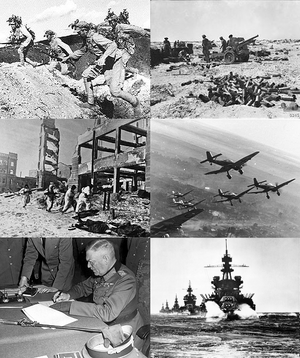

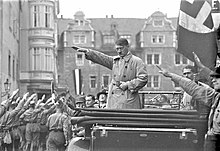
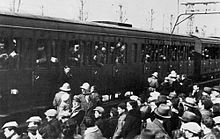
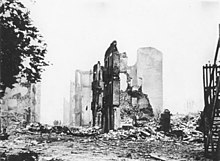


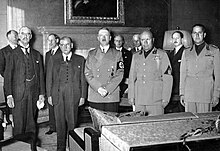
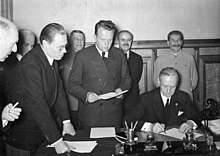
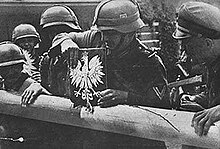

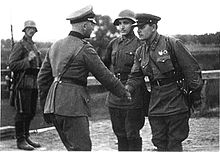




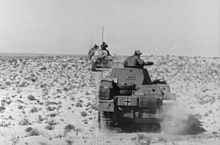
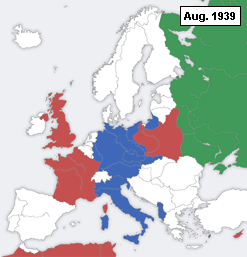
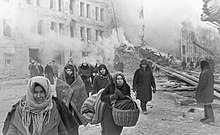

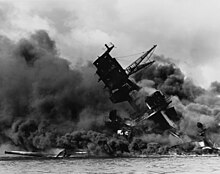
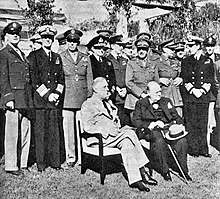
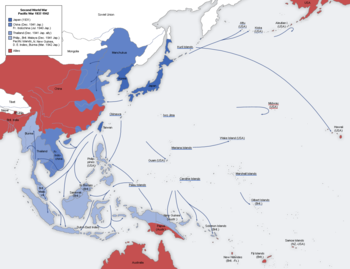











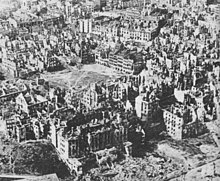


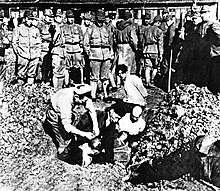





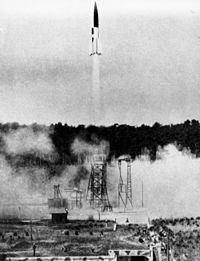


تعليقات
إرسال تعليق